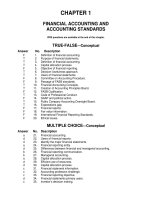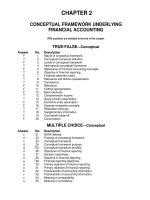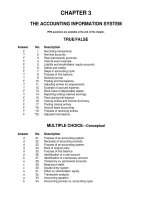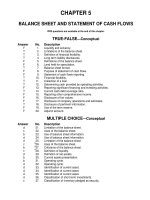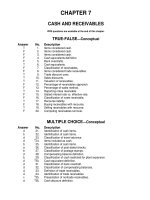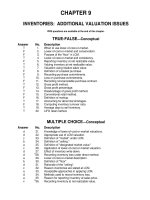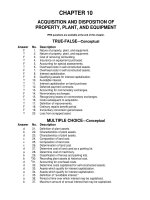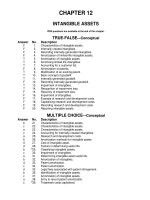Test bank cost accounting 14e by carter ch04
Bạn đang xem bản rút gọn của tài liệu. Xem và tải ngay bản đầy đủ của tài liệu tại đây (73.35 KB, 14 trang )
Chapter 4
COST SYSTEMS AND COST ACCUMULATION
MULTIPLE CHOICE
Question Nos. 7, 9, 12-14, and 16 are AICPA adapted.
Question Nos. 8, 10, 11, and 15 are CIA adapted.
E
1.
The tie-in between general accounts and cost accounts is often discussed with
accounting procedures. An example of a general account is:
A.
Materials
B.
Work in Process
C.
Factory Overhead Control
D.
Finished Goods
E.
Accumulated Depreciation
C
2.
One
A.
B.
C.
D.
E.
A
3.
An industry that would most likely use job order costing procedures is:
A.
road building
B.
fertilizer manufacturing
C.
flour milling
D.
petroleum refining
E.
textile manufacturing
D
4.
An industry that would most likely use process costing procedures is:
A.
musical instrument manufacturing
B.
construction
C.
aircraft
D.
chemicals
E.
office equipment
A
5.
Supplies needed for use in the factory are issued on the basis of:
A.
materials requisitions
B.
time tickets
C.
factory overhead analysis sheets
D.
clock cards
E.
purchase invoices
feature of a standard cost system is that:
selection of the cost unit becomes simplified
predetermined amounts are ignored
an analysis of cost variances is facilitated
historical costs are recorded as they are incurred
reports are delayed until operations have been performed
32
33
Chapter 4
D
6.
Finished Goods is debited and Work in Process is credited for a:
A.
transfer of materials to the factory
B.
return of unused materials from the factory
C.
purchase of goods on account
D.
transfer of completed production
E.
transfer of completed goods out of the factory
B
7.
The best cost accumulation procedure to use when many batches, each differing
as to product specifications, are produced is:
A.
absorption
B.
job order
C.
process
D.
actual
E.
standard
A
8.
Job order costs are most useful for:
A.
determining the cost of a specific project
B.
determining the labor cost involved in production
C.
determining inventory valuation using lifo
D.
estimating overhead costs
E.
controlling indirect costs of future production
E
9.
Under a job order cost system, the dollar amount of the entry to transfer the
inventory from Finished Goods to Cost of Goods Sold is the sum of the costs
charged to all jobs:
A.
completed during the period
B.
started in process during the period
C.
in process during the period
D.
completed and sold during the period
E.
sold during the period
A
10.
The
A.
B.
C.
D.
E.
A
11.
Job order cost accounting systems and process accounting systems differ in the
way:
A.
costs are traced to cost objects
B.
orders are taken and in the number of units in the orders
C.
product profitability is determined and compared with planned costs
D.
manufacturing processes can be accomplished and in the number of
production runs that may be performed in a year
E.
none of the above
D
12.
In a job order cost system, the distribution of direct labor costs usually are
recorded as an increase in:
A.
Cost of Goods Sold
B.
Factory Overhead Control
C.
Finished Goods
D.
Work in Process
E.
none of the above
industry most likely to use job order costing in accounting for costs is:
accounting firms
textile manufacturer
paint manufacturer
oil refinery
none of the above
Cost Systems and Cost Accumulation
C
13.
Process costing techniques should be used in assigning costs to products:
A.
if the product is manufactured on the basis of each order received
B.
when production is only partially completed during the accounting period
C.
if the product is composed of mass-produced homogeneous units
D.
whenever standard costing techniques should not be used
E.
none of the above
A
14.
A characteristic of a process costing system is:
A.
partially processed inventory is restated in terms of completed units
B.
costs are accumulated by order
C.
it is used by a company manufacturing custom machinery
D.
standard costs are not applicable
E.
none of the above
C
15.
The
A.
B.
C.
D.
E.
B
16.
In the computation of manufacturing cost per equivalent unit, the weighted
average method of process costing considers:
A.
current costs only
B.
current costs plus cost of beginning work in process inventory
C.
current costs plus cost of ending work in process inventory
D.
current costs less cost of beginning work in process inventory
E.
none of the above
B
17.
The
A.
B.
C.
D.
E.
element of manufacturing cost that supports time tickets is:
materials
labor
factory overhead
all of the above
none of the above
C
18.
The
A.
B.
C.
D.
E.
element of manufacturing cost that supports depreciation schedules is:
materials
labor
factory overhead
all of the above
none of the above
D
19.
Work in Process is debited and Materials is credited for:
A.
indirect materials requisitioned to production
B.
the completion of work in process
C.
the sale of completed product
D.
direct materials requisitioned to production
E.
materials returned to the storeroom
industry most likely to use process costing in accounting for costs is:
road builder
electrical contractor
airlines
automobile repair shop
none of the above
34
35
Chapter 4
E
20.
Factory Overhead Control is debited and Work in Process is credited for:
A.
indirect materials requisitioned to production
B.
the completion of work in process
C.
the sale of completed product
D.
direct materials requisitioned to production
E.
none of the above
A
21.
Products, operations, and processes costed on the basis of predetermined
quantities of resources to be used and predetermined prices of those resources
are distinguishing characteristics of which:
A.
standard cost system
B.
historical cost system
C.
process cost system
D.
job order cost system
E.
backflush cost system
D
22.
The tax requirement that certain purchasing and storage costs be allocated to
inventory is known as:
A.
backflush costing
B.
postdeduction
C.
just-in-time
D.
super absorption
E.
none of the above
C
23.
The manufacturing systems characterized by short setup times, moderate to low
lead times, and very low direct labor cost is:
A.
manual systems
B.
fixed automation systems
C.
flexible manufacturing systems
D.
process cost systems
E.
job order cost systems
E
24.
The cost accounting system noted for its lack of detailed tracking of work in
process during the accounting period is:
A.
process costing
B.
job order costing
C.
standard costing
D.
actual costing
E.
backflush costing
D
25.
Ziffel Company had the following account balances and results from operations
for the month of July: direct materials consumed, $10,400; direct labor, $8,000;
factory overhead, $8,800; July 1, work in process inventory, $2,400; July 31, work
in process inventory, $1,800; finished goods inventory, July 1, $1,200; finished
goods inventory, July 31, $1,000. The total manufacturing cost for the month of
July was:
A.
$27,800
B.
$28,000
C.
$18,400
D.
$27,200
E.
none of the above
SUPPORTING CALCULATION: $10,400 + $8,000 + $8,800 = $27,200
Cost Systems and Cost Accumulation
C
26.
36
Ziffel Company had the following account balances and results from operations
for the month of July: direct materials consumed, $10,400; direct labor, $8,000;
factory overhead, $8,800; July 1, work in process inventory, $2,400; July 31, work
in process inventory, $1,800; finished goods inventory, July 1, $1,200; finished
goods inventory, July 31, $1,000. The cost of goods manufactured was:
A.
$27,200
B.
$28,000
C.
$27,800
D.
$26,600
E.
none of the above
SUPPORTING CALCULATION: $27,200 + $2,400 - $1,800 = $27,800
B
27.
Ziffel Company had the following account balances and results from operations
for the month of July: direct materials consumed, $10,400; direct labor, $8,000;
factory overhead, $8,800; July 1, work in process inventory, $2,400; July 31, work
in process inventory, $1,800; finished goods inventory, July 1, $1,200; finished
goods inventory, July 31, $1,000. The cost of goods sold was:
A.
$27,200
B.
$28,000
C.
$27,800
D.
$27,600
E.
none of the above
SUPPORTING CALCULATION: $27,800 + $1,200 - $1,000 = $28,000
A
28.
A cost system where only the variable manufacturing costs are allocated to
production is:
A.
direct costing
B.
prime costing
C.
absorption costing
D.
standard costing
E.
none of the above
D
29.
A cost system where all manufacturing cost elements are allocated to production
is:
A.
direct costing
B.
prime costing
C.
standard costing
D.
full absorption costing
E.
none of the above
C
30.
A cost system where only direct material and direct labor costs are allocated to
production is:
A.
direct costing
B.
standard costing
C.
prime costing
D.
full absorption costing
E.
none of the above
37
B
Chapter 4
31.
The manufacturing systems that are characterized by very high setup times,
moderate lead times, and high direct labor cost are:
A.
flexible manufacturing systems
B.
fixed automation systems
C.
manual systems
D.
backflush systems
E.
none of the above
Cost Systems and Cost Accumulation
38
PROBLEMS
PROBLEM
1.
Computation of Total Manufacturing Cost, Cost of Goods Manufactured, and Cost
of Goods Sold. During the past year, the Rocco Company incurred these costs: direct
labor, $2,500,000; factory overhead, $4,000,000; and direct materials purchases,
$1,500,000. Inventories were costed as follows:
Beginning
Finished goods................................................................... $250,000
Work in process................................................................. 450,000
Materials...........................................................................
75,000
Ending
$300,000
550,000
125,000
Required:
(1)
(2)
(3)
Calculate total manufacturing cost for the year.
Calculate the cost of goods manufactured for the year.
Calculate the cost of goods sold for the year.
SOLUTION
(1)
(2)
(3)
Direct materials:
Materials inventory, beginning.............................
Purchases.............................................................
Materials available for use...................................
Less raw materials inventory, ending..................
Direct materials consumed..................................
Direct labor...............................................................
Factory overhead......................................................
Total manufacturing costs.........................................
Total manufacturing costs [from (1)]........................
Add work in process inventory, beginning...........
$
75,000
1,500,000
$1,575,000
125,000
$1,450,000
2,500,000
4,000,000
$ 7,950,000
Less work in process inventory, ending................
Cost of goods manufactured.....................................
$7,950,000
450,000
$8,400,000
550,000
$ 7,850,000
Cost of goods manufactured [from (2)].....................
Add finished goods inventory, beginning.............
Cost of goods available for sale................................
Less finished goods inventory, ending.................
Cost of goods sold.....................................................
$7,850,000
250,000
$8,100,000
300,000
$7,800,000
39
Chapter 4
PROBLEM
2.
Journal Entries for the Cost Accounting Cycle. On January 1, the ledger of the
Phinney Furniture Company contained, among other accounts, the following: Finished
Goods, $25,000; Work in Process, $30,000; Materials, $15,000. During January, the following
transactions were completed:
(a)
(b)
(c)
(d)
(e)
(f)
(g)
(h)
Materials were purchased at a cost of $28,000.
Direct materials in the amount of $21,000 were issued from the storeroom.
Storeroom requisitions for indirect materials and supplies amounted to $3,200.
The total payroll for January amounted to $31,000, including marketing salaries of
$7,500 and administrative salaries of $5,500. Labor time tickets show that $15,500 of
the labor cost was direct labor.
Various factory overhead costs were incurred for $12,000 on account.
Total factory overhead is charged to the work in process account.
Cost of production completed in January totaled $58,000, and finished goods in the
shipping room on January 31 totaled $18,000.
Customers to whom shipments were made during the month were billed for $88,000.
(Also record entry for cost of goods sold.)
Required: Prepare journal entries for the transactions, including the recording, payment,
and distribution of the payroll.
SOLUTION
(a)
(b)
(c)
(d)
(e)
(f)
Materials...................................................................
Accounts Payable.................................................
28,000
Work in Process.........................................................
Materials..............................................................
21,000
Factory Overhead Control..........................................
Materials..............................................................
3,200
Payroll.......................................................................
Accrued Payroll.....................................................
31,000
Accrued Payroll.........................................................
Cash.....................................................................
31,000
Work in Process.........................................................
Factory Overhead Control..........................................
Marketing Expenses Control......................................
Administrative Expenses Control..............................
Payroll..................................................................
15,500
2,500
7,500
5,500
Factory Overhead Control..........................................
Accounts Payable.................................................
12,000
Work in Process.........................................................
Factory Overhead Control.....................................
17,700
28,000
21,000
3,200
31,000
31,000
31,000
12,000
17,700
Cost Systems and Cost Accumulation
(g)
(h)
40
Finished Goods..........................................................
Work in Process....................................................
58,000
Accounts Receivable.................................................
Sales....................................................................
88,000
Cost of Goods Sold (25,000 + 58,000 - 18,000)........
Finished Goods.....................................................
65,000
58,000
88,000
65,000
PROBLEM
3.
Cost of Goods Manufactured Statement. Cuervo Company manufacturers file cabinets
made to consumer specifications. The following information was available at the beginning
of March:
Materials inventory...........................................................
Work in process inventory.................................................
Finished goods inventory...................................................
$12,800
4,700
2,300
During March, materials costing $26,000 were purchased, direct labor cost totaled $19,300,
and factory overhead was $12,500 (including $2,500 of indirect materials). March 31
inventories were:
Materials inventory...........................................................
Work in process inventory.................................................
Finished goods inventory...................................................
$13,300
6,800
2,800
Required: Prepare a cost of goods manufactured statement for March, 19--. (AICPA adapted)
SOLUTION
Cuervo Company
Cost of Goods Manufactured Statement
For the Month Ended March 31, 19-Direct materials:
Materials inventory, March 1........................
Purchases.....................................................
Materials available for use...........................
Less:........................Indirect materials used
Materials inventory, March 31.................
Direct materials consumed..........................
Direct labor.......................................................
Factory overhead..............................................
Total manufacturing cost..................................
Add work in process inventory, March 1...........
Less work in process inventory, March 31.........
Cost of goods manufactured.............................
$12,800
26,000
$38,800
$2,500
13,300
15,800
$23,000
19,300
12,500
$54,800
4,700
$ 59,500
6,800
$52,700
41
Chapter 4
PROBLEM
4.
Income Statement Relationships. The following data are available for three companies
at the end of their fiscal years:
Company Alpha:
Finished goods, April 1...............................................
Cost of goods manufactured.................................
Sales.....................................................................
Gross profit on sales.............................................
Finished goods inventory, March 31......................
$ 400,000
2,600,000
3,500,000
35%
?
Company Beta:
Freight in....................................................................
Purchases returns and allowances........................
Marketing expense................................................
Finished goods, December 31...............................
Cost of goods sold.................................................
Cost of goods available for sale............................
$ 12,000
22,000
85,000
65,000
550,000
?
Company Chi:
Gross profit................................................................
Cost of goods manufactured.................................
Finished goods, January 1.....................................
Finished goods, December 31...............................
Work in process, January 1...................................
Work in process, December 31.............................
Sales.....................................................................
$ 264,000
612,000
34,000
26,000
18,000
12,000
?
Required: Determine the amounts indicated by the question marks.
(AICPA adapted)
Cost Systems and Cost Accumulation
42
SOLUTION
Company Alpha:
Sales..........................................................................
Cost of goods sold:
Finished goods inventory, April 1..........................
Cost of goods manufactured.................................
Cost of goods available for sale............................
Finished goods inventory, March 31......................
Less cost of goods sold.........................................
Gross profit (20% of sales).........................................
$3,500,000
$ 400,000
2,600,000
$3,000,000
725,000
2,275,000
$ 1,225,000
Company Beta:
Cost of goods available for sale.................................
Less finished goods ending inventory........................
Cost of goods sold......................................................
Company Chi:
Sales..........................................................................
Cost of goods sold:
Cost of goods manufactured.................................
Add beginning finished goods inventory...............
Cost of goods available for sale............................
Less ending finished goods inventory...................
Less cost of goods sold.........................................
Gross profit................................................................
$ 615,000
65,000
$ 550,000
$ 884,000
$ 612,000
34,000
$ 646,000
26,000
620,000
$ 264,000
PROBLEM
5.
Cost of Goods Manufactured; Prime and Conversion Costs. Wyoming Company's
purchases of materials during June totaled $25,000, and the cost of goods sold for June was
$130,000. Factory overhead was 200% of direct labor cost. Other information pertaining to
Wyoming Company's inventories and production for June is as follows:
Inventories
Finished goods................................................................
Work in process..............................................................
Materials.........................................................................
Beginning
$42,500
15,500
5,000
Ending
$39,000
17,000
8,500
Required:
(1) Prepare a schedule of cost of goods manufactured.
(2) Compute the prime cost charged to Work in Process.
(3) Compute the conversion cost charged to Work in Process.
(AICPA adapted)
43
Chapter 4
SOLUTION
(1)
Wyoming Company
Schedule of Cost of Goods Manufactured
For Month Ended June 30, 19--
Work in process, June 1..................................................
Production costs:
Direct materials.........................................................
Direct labor................................................................
Factory overhead.......................................................
$ 15,500
21,500 **
35,500
71,000
Less work in process, June 30.........................................
Cost of goods manufactured..........................................
Let x
3x
x
2x
128,000
$143,500
17,000
$ 126,500*
= direct labor
= $106,500
= $35,500 direct labor
= $71,000 factory overhead
(2) Prime cost:
Direct materials [from (1)].................................
Direct labor [from (1)]........................................
(3) Conversion cost:
Direct labor [from (1)]........................................
Factory overhead [from (1)]...............................
$ 21,500
35,500
$ 57,000
$ 35,500
71,000
$106,500 ***
*
Cost of goods sold ($130,000) + ending finished goods inventory ($39,000) - beginning
finished goods inventory ($42,500) = $126,500.
**
Purchases of materials during June ($25,000) + beginning materials inventory ($5,000)
- ending materials inventory ($8,500) = $21,500.
*** Production costs for June ($128,000) - direct materials ($21,500) = direct labor and
factory overhead ($106,500).
PROBLEM
6.
Cost of Goods Manufactured and Sold. For May, Jimbo Inc. had cost of goods
manufactured equal to $90,000; direct materials used $30,000; cost of goods sold,
$100,000; direct labor, $38,000; purchases of materials, $40,000; cost of goods available
for sale, $125,000; and total factory labor, $48,000. Work in process was $25,000 on May 1
and $15,000 on May 31. The company uses a single materials account for direct and
indirect materials.
Cost Systems and Cost Accumulation
44
Required: Prepare the following:
(1) A cost of goods sold statement. For brevity, show single-line items for factory overhead
and direct materials used.
(2) Summary general journal entries to record:
(a) purchase of materials on account
(b) use of materials, including direct materials of 1,000
(c) accrual of factory payroll, including indirect labor of $10,000 (use a payroll
clearing account)
(d) distribution of factory labor cost
(e) transfer of completed work to finished goods
(f) sales on account, at a markup equal to 100% of production cost
SOLUTION
(1)
Jimbo Inc.
Cost of Goods Sold Statement
For Month Ended May 31, 19-(in thousands)
Direct materials consumed............................................
Direct labor.....................................................................
Factory overhead............................................................
Total manufacturing cost [Note (a)]...............................
Add work in process inventory, May 1............................
$ 30
38
12
$ 80
25
$105
15
$ 90
35
$125
25
$ 100
Less work in process inventory, May 31.........................
Cost of goods manufactured..........................................
Add finished goods inventory, May 1 [Note (b)].............
Cost of goods available for sale......................................
Less finished goods inventory, May 31 [Note (c)]...........
Cost of goods sold..........................................................
Note (a): Cost of goods manufactured............................
Add work in process, ending............................
Less work in process, beginning......................
Equals total manufacturing cost......................
$ 90
15
$105
25
$ 80
Note (b): Cost of goods available for sale.......................
Less cost of goods manufactured.....................
Equals finished goods, beginning.....................
$125
90
$ 35
Note (c): Cost of goods available for sale.......................
Less cost of goods sold.....................................
Equals finished goods, ending.........................
$125
100
$ 25
45
Chapter 4
(2)
(a) Materials.................................................................
Accounts Payable...............................................
40,000
(b) Work in Process.......................................................
Factory Overhead Control........................................
Materials.............................................................
30,000
1,000
(c) Payroll ($38,000 + $10,000)...................................
Accrued Payroll...................................................
48,000
(d) Work in Process.......................................................
Factory Overhead Control........................................
Payroll.................................................................
38,000
10,000
(e) Finished Goods........................................................
Work in Process..................................................
90,000
(f)
40,000
31,000
48,000
48,000
90,000
Accounts Receivable................................................
Sales [$100,000 + (100% of $100,000)]............
200,000
Cost of Goods Sold...................................................
Finished Goods...................................................
100,000
200,000
100,000
